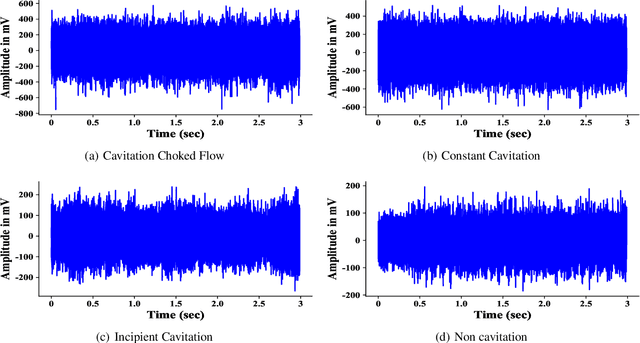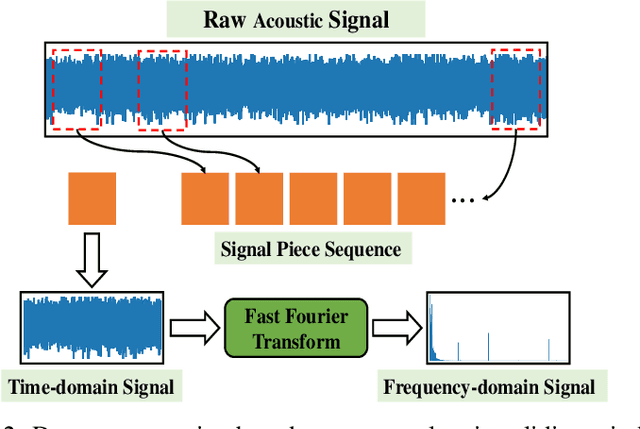Johannes Faber
SMTNet: Hierarchical cavitation intensity recognition based on sub-main transfer network
Mar 23, 2022



Abstract:With the rapid development of smart manufacturing, data-driven machinery health management has been of growing attention. In situations where some classes are more difficult to be distinguished compared to others and where classes might be organised in a hierarchy of categories, current DL methods can not work well. In this study, a novel hierarchical cavitation intensity recognition framework using Sub-Main Transfer Network, termed SMTNet, is proposed to classify acoustic signals of valve cavitation. SMTNet model outputs multiple predictions ordered from coarse to fine along a network corresponding to a hierarchy of target cavitation states. Firstly, a data augmentation method based on Sliding Window with Fast Fourier Transform (Swin-FFT) is developed to solve few-shot problem. Secondly, a 1-D double hierarchical residual block (1-D DHRB) is presented to capture sensitive features of the frequency domain valve acoustic signals. Thirdly, hierarchical multi-label tree is proposed to assist the embedding of the semantic structure of target cavitation states into SMTNet. Fourthly, experience filtering mechanism is proposed to fully learn a prior knowledge of cavitation detection model. Finally, SMTNet has been evaluated on two cavitation datasets without noise (Dataset 1 and Dataset 2), and one cavitation dataset with real noise (Dataset 3) provided by SAMSON AG (Frankfurt). The prediction accurcies of SMTNet for cavitation intensity recognition are as high as 95.32%, 97.16% and 100%, respectively. At the same time, the testing accuracies of SMTNet for cavitation detection are as high as 97.02%, 97.64% and 100%. In addition, SMTNet has also been tested for different frequencies of samples and has achieved excellent results of the highest frequency of samples of mobile phones.
A multi-task learning for cavitation detection and cavitation intensity recognition of valve acoustic signals
Mar 01, 2022



Abstract:With the rapid development of smart manufacturing, data-driven machinery health management has received a growing attention. As one of the most popular methods in machinery health management, deep learning (DL) has achieved remarkable successes. However, due to the issues of limited samples and poor separability of different cavitation states of acoustic signals, which greatly hinder the eventual performance of DL modes for cavitation intensity recognition and cavitation detection. In this work, a novel multi-task learning framework for simultaneous cavitation detection and cavitation intensity recognition framework using 1-D double hierarchical residual networks (1-D DHRN) is proposed for analyzing valves acoustic signals. Firstly, a data augmentation method based on sliding window with fast Fourier transform (Swin-FFT) is developed to alleviate the small-sample issue confronted in this study. Secondly, a 1-D double hierarchical residual block (1-D DHRB) is constructed to capture sensitive features from the frequency domain acoustic signals of valve. Then, a new structure of 1-D DHRN is proposed. Finally, the devised 1-D DHRN is evaluated on two datasets of valve acoustic signals without noise (Dataset 1 and Dataset 2) and one dataset of valve acoustic signals with realistic surrounding noise (Dataset 3) provided by SAMSON AG (Frankfurt). Our method has achieved state-of-the-art results. The prediction accurcies of 1-D DHRN for cavitation intensitys recognition are as high as 93.75%, 94.31% and 100%, which indicates that 1-D DHRN outperforms other DL models and conventional methods. At the same time, the testing accuracies of 1-D DHRN for cavitation detection are as high as 97.02%, 97.64% and 100%. In addition, 1-D DHRN has also been tested for different frequencies of samples and shows excellent results for frequency of samples that mobile phones can accommodate.
An acoustic signal cavitation detection framework based on XGBoost with adaptive selection feature engineering
Mar 01, 2022



Abstract:Valves are widely used in industrial and domestic pipeline systems. However, during their operation, they may suffer from the occurrence of the cavitation, which can cause loud noise, vibration and damage to the internal components of the valve. Therefore, monitoring the flow status inside valves is significantly beneficial to prevent the additional cost induced by cavitation. In this paper, a novel acoustic signal cavitation detection framework--based on XGBoost with adaptive selection feature engineering--is proposed. Firstly, a data augmentation method with non-overlapping sliding window (NOSW) is developed to solve small-sample problem involved in this study. Then, the each segmented piece of time-domain acoustic signal is transformed by fast Fourier transform (FFT) and its statistical features are extracted to be the input to the adaptive selection feature engineering (ASFE) procedure, where the adaptive feature aggregation and feature crosses are performed. Finally, with the selected features the XGBoost algorithm is trained for cavitation detection and tested on valve acoustic signal data provided by Samson AG (Frankfurt). Our method has achieved state-of-the-art results. The prediction performance on the binary classification (cavitation and no-cavitation) and the four-class classification (cavitation choked flow, constant cavitation, incipient cavitation and no-cavitation) are satisfactory and outperform the traditional XGBoost by 4.67% and 11.11% increase of the accuracy.
Regional-Local Adversarially Learned One-Class Classifier Anomalous Sound Detection in Global Long-Term Space
Feb 26, 2022



Abstract:Anomalous sound detection (ASD) is one of the most significant tasks of mechanical equipment monitoring and maintaining in complex industrial systems. In practice, it is vital to precisely identify abnormal status of the working mechanical system, which can further facilitate the failure troubleshooting. In this paper, we propose a multi-pattern adversarial learning one-class classification framework, which allows us to use both the generator and the discriminator of an adversarial model for efficient ASD. The core idea is learning to reconstruct the normal patterns of acoustic data through two different patterns of auto-encoding generators, which succeeds in extending the fundamental role of a discriminator from identifying real and fake data to distinguishing between regional and local pattern reconstructions. Furthermore, we present a global filter layer for long-term interactions in the frequency domain space, which directly learns from the original data without introducing any human priors. Extensive experiments performed on four real-world datasets from different industrial domains (three cavitation datasets provided by SAMSON AG, and one existing publicly) for anomaly detection show superior results, and outperform recent state-of-the-art ASD methods.
 Add to Chrome
Add to Chrome Add to Firefox
Add to Firefox Add to Edge
Add to Edge